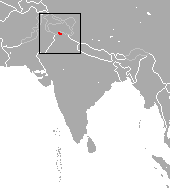Kashmir gray langur
| Kashmir gray langur[1] | |
|---|---|
| Scientific classification | |
| Kingdom: | |
| Phylum: | |
| Class: | |
| Order: | |
| Family: | |
| Genus: | |
| Species: | S. ajax
|
| Binomial name | |
| Semnopithecus ajax Pocock, 1928
| |

| |
| Kashmir Gray Langur range | |
The Kashmir gray langur (Semnopithecus ajax) is an Old World monkey, one of the species of langurs. This, like other gray langurs, is a leaf-eating monkey. It has been reported from northern India west into Pakistani Kashmir[1] and in Nepal, but evidence indicates it only occurs within a single valley in Himachal Pradesh, India.[2]
It was formerly considered a subspecies of Semnopithecus entellus and is one of several Semnopithecus species named after characters from The Iliad, along with Semnopithecus hector and Semnopithecus priam.[3]
The Kashmir gray langur is considered to be endangered. This is due to its restricted range, fragmented population, and threats from human agriculture and development activities.[2] It is arboreal and diurnal, and lives in several types of forests at altitudes between 2200 and 4000 meters.[2]
The birthing season for the Kashmir gray langur runs from January through June, although almost half of all infants are born in March.[4] The infants are weaned at a higher age than most Asian colobines. While most Asian colobines wean their young within the first year, Kashmir gray langurs wean their young on average at 25 months.[4] This is apparently due to nutritional constraints, since monkeys in poorer sites wean their young at an older age.[4] The interbirth interval for females is about 2.4 years.[4]
Alloparental care occurs in Kashmir's gray langur for up to 5 months.[4] Males are usually protective of infants, but infanticide occasionally occurs.[4]
Although most Asian colobine groups contain only a single adult male and multiple females, multimale groups are known to occur within Semnopithecus species. With Kashmir's Gray Langur, multimale groups may include as many as five adult males.[4] Females initiate copulation by soliciting a male, but not all solicitations result in copulation.[4]
References
- ^ a b Groves, C. P. (2005). Wilson, D. E.; Reeder, D. M. (eds.). Mammal Species of the World: A Taxonomic and Geographic Reference (3rd ed.). Baltimore: Johns Hopkins University Press. p. 174. ISBN 0-801-88221-4. OCLC 62265494.
- ^ a b c d Template:IUCN2008
- ^ Groves, C. P. (2005). Wilson, D. E.; Reeder, D. M. (eds.). Mammal Species of the World: A Taxonomic and Geographic Reference (3rd ed.). Baltimore: Johns Hopkins University Press. pp. 174–175. ISBN 0-801-88221-4. OCLC 62265494.
- ^ a b c d e f g h R. Craig Kirkpatrick (2007). "The Asian Colobines". In Christina J. Campbell, Agustin Fuentes, Katherine C. MacKinnon, Melissa Panger and Simon K. Bearder (ed.). Primates in Perspective. pp. 191–193, 196. ISBN 978-0-19-517133-4.
{{cite book}}: CS1 maint: multiple names: editors list (link)

